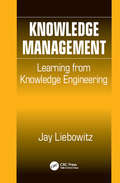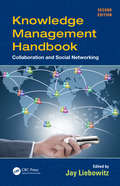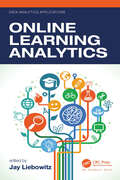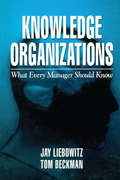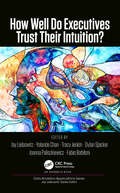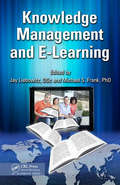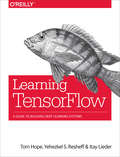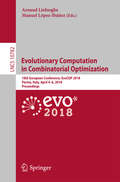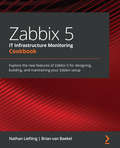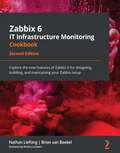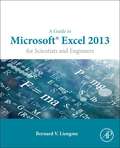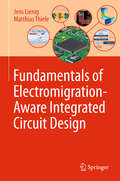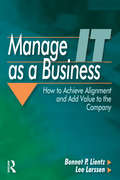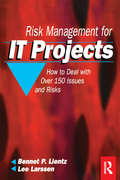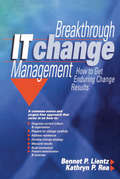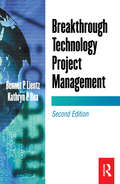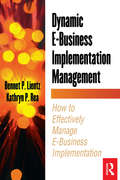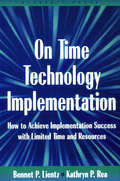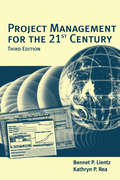- Table View
- List View
Knowledge Management: Learning from Knowledge Engineering
by Jay LiebowitzKnowledge Management (KM) is strongly rooted in the discipline of Knowledge Engineering (KE), which in turn grew partly out of the artificial intelligence field. Despite their close relationship, however, many KM specialists have failed to fully recognize the synergy or acknowledge the power that KE methodologies, techniques, and tools hold for enh
Knowledge Management Handbook: Collaboration and Social Networking, Second Edition
by Jay LiebowitzRecent research shows that collaboration and social networking foster knowledge sharing and innovation by sparking new connections, ideas, and practices. Yet these informal networks are often misunderstood and poorly managed. Building on the groundbreaking, bestselling first edition, Knowledge Management Handbook: Collaboration and Social Networkin
Online Learning Analytics (Data Analytics Applications)
by Jay Liebowitz"In our increasingly digitally enabled education world, analytics used ethically, strategically, and with care holds the potential to help more and more diverse students be more successful on higher education journeys than ever before. Jay Liebowitz and a cadre of the fields best ‘good trouble’ makers in this space help shine a light on the possibilities, potential challenges, and the power of learning together in this work." —Mark David Milliron, Ph.D., Senior Vice President and Executive Dean of the Teachers College, Western Governors University Due to the COVID-19 pandemic and its aftereffects, we have begun to enter the "new normal" of education. Instead of online learning being an "added feature" of K–12 schools and universities worldwide, it will be incorporated as an essential feature in education. There are many questions and concerns from parents, students, teachers, professors, administrators, staff, accrediting bodies, and others regarding the quality of virtual learning and its impact on student learning outcomes. Online Learning Analytics is conceived on trying to answer the questions of those who may be skeptical about online learning. Through better understanding and applying learning analytics, we can assess how successful learning and student/faculty engagement, as examples, can contribute towards producing the educational outcomes needed to advance student learning for future generations. Learning analytics has proven to be successful in many areas, such as the impact of using learning analytics in asynchronous online discussions in higher education. To prepare for a future where online learning plays a major role, this book examines: Data insights for improving curriculum design, teaching practice, and learning Scaling up learning analytics in an evidence-informed way The role of trust in online learning. Online learning faces very real philosophical and operational challenges. This book addresses areas of concern about the future of education and learning. It also energizes the field of learning analytics by presenting research on a range of topics that is broad and recognizes the humanness and depth of educating and learning.
Knowledge Organizations: What Every Manager Should Know
by Jay Liebowitz Thomas J. BeckmanFor knowledge management to be successful, the corporate culture needs to be adapted to encourage the creation, sharing, and distribution of knowledge within the organization. Knowledge Organizations: What Every Manager Should Know provides insight into how organizations can best accomplish this goal. Liebowitz and Beckman provide the information companies need for evaluating and planning the steps and processes that will transform their existing organization infrastructure into a "knowledge-based" organization. This easy-to-read guide includes many vignettes, examples, and short cases of organizations involved in knowledge management.
How Well Do Executives Trust Their Intuition (Data Analytics Applications)
by Jay Liebowitz Yolande Chan Tracy Jenkin Dylan Spicker Joanna Paliszkiewicz Fabio BabiloniIn this age of Big Data and analytics, knowledge gained through experiential learning and intuition may be taking a back seat to analytics. However, the use of intuition should not be underestimated and should play an important role in the decision process. <P><P>How Well Do Executives Trust Their Intuition covers the Fulbright research study conducted by this international team of editors. The main question of their investigation is: How well do executives trust their intuition? In other words, do they typically prefer intuition over analysis and analytics. And equally importantly, what types of intuition may be most favorable looking at different variables? The research utilizes survey and biometrics approaches with C-level executives from Canada, U.S., Poland, and Italy. <P><P>In addition, the book contains chapters from leading executives in industry, academia, and government. Their insights provide examples of how their intuition enabled key decisions that they made. <P><P>This book covers such topics as: <li>Using intuition <li>How gender, experience, role, industry, and country affect intuition <li>Trust and intuition in management <li>Trusting intuition <li>It’s a matter of heart <li>Leadership intuition and the future of work <li>Creating an intuitive awareness for executives <li>Improvisation and instinct. <P><P>The book explores how executives can use intuition to guide decision making. It also explains how to trust intuition-based decisions. How Well Do Executives Trust Their Intuition is a timely and prescient reminder in this age of data-driven analytics that human insight, instinct, and intuition should also play key roles.
Knowledge Management and E-Learning
by Jay Liebowitz Michael S. FrankThe rapidly growing demand for online courses and supporting technology has resulted in a plethora of structural and functional changes and challenges for universities and colleges. These changes have led many distance education providers to recognize the value of understanding the fundamental concepts of both e-learning and knowledge management (K
Intuition, Trust, and Analytics (Data Analytics Applications)
by Jay Liebowitz Joanna Paliszkiewicz Jerzy GołuchowskiIn order to make informed decisions, there are three important elements: intuition, trust, and analytics. Intuition is based on experiential learning and recent research has shown that those who rely on their “gut feelings” may do better than those who don’t. Analytics, however, are important in a data-driven environment to also inform decision making. The third element, trust, is critical for knowledge sharing to take place. These three elements—intuition, analytics, and trust—make a perfect combination for decision making. This book gathers leading researchers who explore the role of these three elements in the process of decision-making.
Knowledge Management in Public Health
by Jay Liebowitz Richard A. Schieber Joanne D. AndreadisClose collaboration across agencies and international borders is mandatory for public health officials. A powerful tool for sharing knowledge, knowledge management (KM) can help public health professionals quickly collaborate and disseminate knowledge for solving public health issues worldwide. The latest initiatives for reforming healthcare have put the spotlight on the need for maximizing resources. In addition to providing a platform for sharing knowledge, KM can help healthcare professionals do more with less. One tool, two problems solved. Yet the sharing of knowledge and KM continues to be a major challenge in the public health field. Knowledge Management in Public Health provides a general introduction to KM and social networking in the public health arena. The book begins with coverage of basic principles, components, and methodologies as well as trends and key issues in public health. It includes ten case studies illustrating applications of KM and social networking in public health. The chapters are written by leading individuals from organizations involved in applying KM in public health worldwide. The editors and chapter authors explore the many elements of KM, delineating how and why to start such an initiative. They provide specific examples of the development and value-added benefits of KM in a variety of public health environments. Tough or quick decision making has always benefitted enormously from knowledge based on the maximum amount of pertinent information available at the time—this has not changed. What is new in the present public health environment is the need to do this more often, with fewer personnel available, and increased expectations relative to the services expected by the public. Better use of information under a KM system is well suited to serve that purpose. This book explores the many ways to use KM to anticipate potential health issues and quickly resolve key incidents when they occur.
Learning TensorFlow: A Guide to Building Deep Learning Systems
by Itay Lieder Tom Hope Yehezkel S. ResheffRoughly inspired by the human brain, deep neural networks trained with large amounts of data can solve complex tasks with unprecedented accuracy. This practical book provides an end-to-end guide to TensorFlow, the leading open source software library that helps you build and train neural networks for computer vision, natural language processing (NLP), speech recognition, and general predictive analytics.Authors Tom Hope, Yehezkel Resheff, and Itay Lieder provide a hands-on approach to TensorFlow fundamentals for a broad technical audience—from data scientists and engineers to students and researchers. You’ll begin by working through some basic examples in TensorFlow before diving deeper into topics such as neural network architectures, TensorBoard visualization, TensorFlow abstraction libraries, and multithreaded input pipelines. Once you finish this book, you’ll know how to build and deploy production-ready deep learning systems in TensorFlow.Get up and running with TensorFlow, rapidly and painlesslyLearn how to use TensorFlow to build deep learning models from the ground upTrain popular deep learning models for computer vision and NLPUse extensive abstraction libraries to make development easier and fasterLearn how to scale TensorFlow, and use clusters to distribute model trainingDeploy TensorFlow in a production setting
Digital Crime and Digital Terrorism (3rd Edition)
by John Liederbach Robert W. Taylor Eric J. FritschThis book focuses on both the technical aspects of digital crime as well as behavioral aspects of computer hackers, virus writers, terrorists and other offenders. Using real life examples and case studies, the book examines the history, development, extent and types of digital crime and digital terrorism as well as current legislation and law enforcement practices designed to prevent, investigate and prosecute these crimes. For professionals in the technical field as well as forensic investigators and other criminal justice professionals.
Informationssicherheit: Möglichkeiten und Grenzen
by Thomas LiedtkeDieses Buch erklärt die wichtigsten Fachbegriffe und Inhalte und ordnet diese den entsprechenden Bereichen zu. Einbezogen werden auch scheinbare Randgebiete, die für die Informationssicherheit ebenfalls eine Rolle spielen. So wird der Themenkomplex Safety und Privacy hinsichtlich seiner Gemeinsamkeiten und Unterschiede beleuchtet. Das Buch zeigt aktuell verwendete Angriffsmuster und wie man sich dagegen schützen kann. Schutz muss dabei sowohl auf technischer Ebene (z. B. durch den Einsatz von Kryptographie) als auch auf organisatorischer und personeller Ebene (z. B. durch entsprechende Managementsysteme und Awareness-Schulungen) erfolgen. Wie lässt sich feststellen, wie sicher Daten sind? Wie lassen sich relevante Bedrohungen finden, gegen die man sich schützen muss? Wie verlaufen Risikoanalysen?
Evolutionary Computation in Combinatorial Optimization: 18th European Conference, EvoCOP 2018, Parma, Italy, April 4–6, 2018, Proceedings (Lecture Notes in Computer Science #10782)
by Arnaud Liefooghe Manuel López-IbáñezThis book constitutes the refereed proceedings of the 18th European Conference on Evolutionary Computation in Combinatorial Optimization, EvoCOP 2018, held in Parma, Italy, in April 2018, co-located with the Evo* 2018 events EuroGP, EvoMUSART and EvoApplications. The 12 revised full papers presented were carefully reviewed and selected from 37 submissions. The papers cover a wide spectrum of topics, ranging from the foundations of evolutionary computation algorithms and other search heuristics, to their accurate design and application to both single- and multi-objective combinatorial optimization problems. Fundamental and methodological aspects deal with runtime analysis, the structural properties of fitness landscapes, the study of metaheuristics core components, the clever design of their search principles, and their careful selection and configuration by means of automatic algorithm configuration and hyper-heuristics. Applications cover conventional academic domains such as NK landscapes, binary quadratic programming, traveling salesman, vehicle routing, or scheduling problems, and also include real-world domains in clustering, commercial districting and winner determination.
Evolutionary Computation in Combinatorial Optimization: 19th European Conference, EvoCOP 2019, Held as Part of EvoStar 2019, Leipzig, Germany, April 24–26, 2019, Proceedings (Lecture Notes in Computer Science #11452)
by Arnaud Liefooghe Luís PaqueteThis book constitutes the refereed proceedings of the 19th European Conference on Evolutionary Computation in Combinatorial Optimization, EvoCOP 2019, held as part of Evo* 2019, in Leipzig, Germany, in April 2019, co-located with the Evo* 2019 events EuroGP, EvoMUSART and EvoApplications.The 14 revised full papers presented were carefully reviewed and selected from 37 submissions. The papers cover a wide spectrum of topics, ranging from the foundations of evolutionary computation algorithms and other search heuristics to their accurate design and application to both single- and multi-objective combinatorial optimization problems. Fundamental and methodological aspects deal with runtime analysis, the structural properties of fitness landscapes, the study of metaheuristics core components, the clever design of their search principles, and their careful selection and configuration. Applications cover domains such as scheduling, routing, partitioning and general graph problems.
Zabbix 5 IT Infrastructure Monitoring Cookbook: Explore the new features of Zabbix 5 for designing, building, and maintaining your Zabbix setup
by Nathan Liefting Brian van BaekelDiscover practical recipes to help you efficiently monitor enterprise IT infrastructure for Windows, Linux, and networkingKey FeaturesFind out how you can leverage some of the most exciting features of Zabbix 5Perform professional IT infrastructure and application monitoring on multiple platformsDiscover easy-to-follow, practical solutions to problems in network monitoring with ZabbixBook DescriptionZabbix offers useful insights into your infrastructure performance and issues and enables you to enhance your monitoring setup with its variety of powerful features. This book covers hands-on, easy-to-follow recipes for using Zabbix 5 for effectively monitoring the performance of devices and applications over networks. The book starts by guiding you through the installation of Zabbix and using the Zabbix frontend. You'll then work your way through the most prominent features of Zabbix and make the right design choices for building a scalable and easily manageable environment. The book contains recipes for building items and triggers for different types of monitoring, building templates, and using Zabbix proxies. As you advance, you'll learn how to use the Zabbix API for customization and manage your Zabbix server and database efficiently. Finally, you'll find quick solutions to the common and not-so-common problems that you may encounter in your everyday Zabbix monitoring work. By the end of this Zabbix book, you'll have learned how to use Zabbix for all your monitoring needs and be able to build a solid Zabbix setup by leveraging its key functionalities.What you will learnExplore the different types of monitoring available in Zabbix 5Find out how to build your own Zabbix templatesUse Zabbix proxies for effective load balancing/scalingWork with custom integrations and the Zabbix APISet up triggers and alerting with Zabbix 5Maintain your Zabbix setup for scaling, backups, and upgradesDiscover how to perform advanced Zabbix database managementMonitor cloud-based products such as Amazon Web Services (AWS), Azure, and DockerWho this book is forThis book is for IT engineers who want to get started with Zabbix and anyone with an intermediate understanding of Zabbix looking to extend their knowledge. Although not necessary, prior experience with Zabbix will help you to make the most of this book.
Zabbix 6 IT Infrastructure Monitoring Cookbook: Explore the new features of Zabbix 6 for designing, building, and maintaining your Zabbix setup, 2nd Edition
by Nathan Liefting Brian van Baekel Dmitry LambertDiscover practical recipes to help you efficiently monitor enterprise IT infrastructure for Microsoft Windows, Linux, networking, and moreKey FeaturesFind out how you can leverage some of the most exciting features of Zabbix 6Perform professional IT infrastructure and application monitoring on multiple platformsDiscover easy-to-follow, practical solutions to problems in network monitoring with ZabbixBook DescriptionThis updated second edition of the Zabbix 6 IT Infrastructure Monitoring Cookbook brings you new recipes, updated with Zabbix 6 functionality. You'll learn how to set up Zabbix with built-in high availability, use the improved Business Service Monitoring, set up automatic reporting, and create advanced triggers. Zabbix offers useful insights into your infrastructure performance and issues and enables you to enhance your monitoring setup with its powerful features. This book covers hands-on, easy-to-follow recipes for using Zabbix 6 to monitor effectively the performance of devices and applications over the network.You'll start by working your way through the installation and most prominent features of Zabbix and make the right design choices for building a scalable and easily manageable environment. This Zabbix book contains recipes for building items and triggers for different types of monitoring, building templates, and using Zabbix proxies. Next, you'll use the Zabbix API for customization and manage your Zabbix server and database efficiently. Finally, you'll find quick solutions to the common and not-so-common problems that you may encounter in your Zabbix monitoring work.By the end of this book, you'll be able to use Zabbix for all your monitoring needs and build a solid Zabbix setup by leveraging its key functionalities.What you will learnImplement your high-availability Zabbix setupBuild templates and explore the different types of monitoring available in Zabbix 6Use Zabbix proxies to scale your environment effectivelyWork with custom integrations and the Zabbix APISet up advanced triggers and effective alertingMaintain your Zabbix setup for scaling, backups, and upgradesDiscover how to perform advanced Zabbix database managementMonitor cloud-based products such as Amazon Web Services (AWS), Azure, and DockerWho this book is forThis book is for IT engineers who want to get started with Zabbix and anyone with an intermediate-level understanding of Zabbix looking to extend their knowledge. Although not necessary, prior experience with Zabbix will help you to make the most of this book.
Prospective Ergonomics
by André LiemThis book argues for a prospective turn in ergonomics to challenge the established fields of strategic design (SD) and management. Its multi-disciplinary outlook builds upon concepts derived from Management, Innovation and Design Science. Differences, similarities and relationships between strategic design and prospective ergonomics are reviewed using existing theories and frameworks from design, ergonomics, and strategic and innovation management. To complement the theory, 12 cases have been analyzed in greater depth according to 4 main dimensions of analysis. Outcomes have shown that innovating through the Prospective Ergonomics (PE) approach is about finding the right balance between, on the one hand, meeting primary objectives such as profit maximization or solving the design problem, and on the other, acknowledging that human activity is bounded by rationality. This means that humans have diverse motives.
A Guide to Microsoft Excel 2013 for Scientists and Engineers
by Bernard V. LiengmeThis text provides a tutorial to using the functions of Microsoft Excel, guiding the reader from basic principles through to more complicated areas such as formulae, charts, curve-fitting, equation solving, integration, macros, statistical functions, and presenting quantitative data.
Fundamentals of Electromigration-Aware Integrated Circuit Design
by Jens Lienig Matthias ThieleThe book provides a comprehensive overview of electromigration and its effects on the reliability of electronic circuits. It introduces the physical process of electromigration, which gives the reader the requisite understanding and knowledge for adopting appropriate counter measures. A comprehensive set of options is presented for modifying the present IC design methodology to prevent electromigration. Finally, the authors show how specific effects can be exploited in present and future technologies to reduce electromigration’s negative impact on circuit reliability.
Manage IT as a Business: How To Achieve Alignment And Add Value To The Company
by Bennet Lientz Lee LarssenMany IT projects fail to deliver the benefits to the business that were promised. Yet IT managers and staff work hard to meet the needs of the business: Systems are put in place; network operations are reliable and stable. The cause is usually a misalignment of IT with the business. In this book, Bennet Lientz and Lee Larssen present over 200 specific, practical guidelines and steps that show how to: align IT and the business, develop methods that make IT more proactive in helping the business, more effectively manage vendors, avoid negative surprises, ensure that more projects are completed on time and within budget, among other things. The techniques in this book have been implemented in over 60 organizations around the world and in over 20 different industries, and the authors include several examples in each chapter to illustrate their points. Follow these proven recommendations to manage IT as a business that adds value to the company.
Risk Management for IT Projects
by Bennet Lientz Lee LarssenThe rate of failure of IT projects has remained little changed in survey after survey over the past 15-20 years—over 40-50%. This has happened in spite of new technology, innovative methods and tools, and different management methods. Why does this happen? Why can’t the situation be better? One reason is that many think of each IT effort as unique. In reality many IT projects are very similar at a high, strategic level. Where they differ is in the people and exact events—the detail. If you read the literature or have been in information systems or IT for some time, you have seen the same reasons for failure and the same problems and issues recur again and again. In this book IT Management experts Ben Lientz and Lee Larssen show you how to identify and track the recurring issues leading to failure in IT projects and provide a proven, modern method for addressing them. By following the recommendations in this books readers can significantly reduce the risk of IT failures and increase the rate of success. Benefits of using this approach:• Issues are identified earlier—giving more time for solution and action.• Issues are resolved more consistently since the approach tracks on their repetition.• You get an early warning of problems in IT work—before the budget or schedule fall apart.• Management tends to have more realistic expectations with an awareness of issues.• Users and managers have greater confidence in IT due to the improved handling of issues.• Since the number of issues tends to stabilize in an organization, the IT organization and management get better at detecting, preventing, and dealing with issues over time—cumulative improvement.• Giving attention to issues make users more realistic in their requests and acts to deter requirement changes and scope creep.
Breakthrough IT Change Management
by Bennet Lientz Kathryn ReaThis is a *different* book on change management. Using commonsense and practical advice tested in their work with hundreds of organizations, the authors walk the reader through clear guidelines and checklists to implement change that works. Readers will develop a change management strategythat starts by diagnosing the current culture and organization, then prepares for change carefully, addresses resistance to change, develops the change strategy, measures results, builds momentum for further change, and prevents deterioration and reversion. The authors then apply their framework to two areas that are major targets for change management: implementing new technology and systems and implementing successful e-business strategies. Included throughout are real-world examples from a number of industries and government.
Breakthrough Technology Project Management
by Bennet Lientz Kathryn ReaAlthough there are many books of methods and tools in different areas, few books actually give detailed tips and lessons on how to effectively set up and manage projects. Most books on project management devote all their space to specific methods. Breakthrough Technology Project Management, Second Edition provides tangible guidelines through examples and suggestions to help people participate in and manage projects more effectively. The authors' techniques and guidelines have been proven over the past 15 years in courses and counseling. This book is a valuable tool for those working in information systems, engineering, computer science, operations and production, and other environments involving project management.
Dynamic E-Business Implementation Management
by Bennet Lientz Kathryn ReaImplementing e-business requires a dynamic approach that can respond to changes in technology, management direction, customer and supplier behavior, and competition. Many traditional project management methods don't work with e-business. This book presents proven real world management methods that are adaptive, dynamic, and flexible in an e-business environment. It tackles the central issues of e-business: the burgeoning market for "buy-side" extranet/Internet procurement and supply chain management/business-to-business, Web-based transactions.
On Time Technology Implementation
by Bennet Lientz Kathryn ReaOn Time Technology Implementation presents technology implementation guidelines and lessons learned from over 30 years of successful, hands-on project experience.
Project Management for the 21st Century
by Bennet Lientz Kathryn ReaThe challenge of managing projects is to combine the technology of the future with lessons from the past. In the Third Edition of Project Management for the 21st Century, noted authors Bennet Lientz and Kathryn Rea provide a modern, proven approach to project management. Properly applied without massive administrative overhead, project management can supply structure, focus, and control to drive work to success.Third Edition revisions include: 35% new material; three new chapters on risk management, international and multinational projects, project culture; entire text rewritten to take advantage of the Web and Internet tools; new appendix covering web sites; additional materials on "what to do next"; more feedback from readers and lessons learned.
